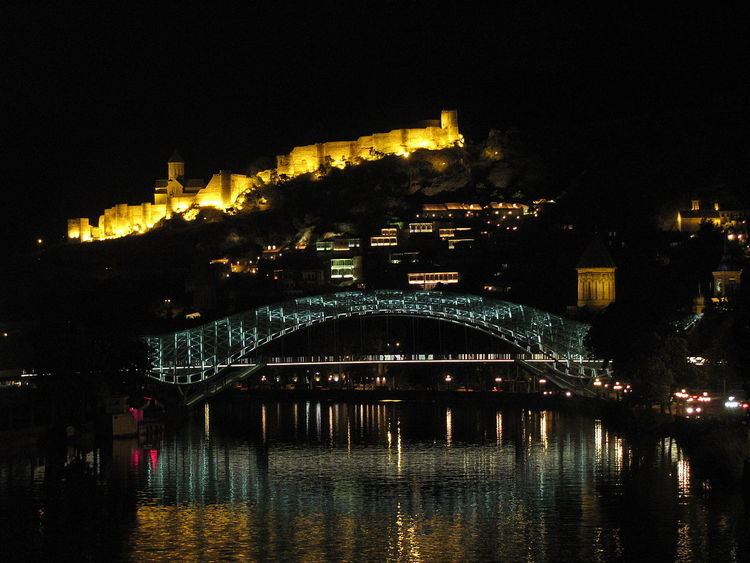Crosses Kura River (Mtkvari) Total length 150 m | Opened 6 May 2010 Width 5 m Body of water Kura | |
 | ||
Maintained by Tbilisi City Administration Address The Bridge of Peace, Tbilisi, Georgia Bridge type Truss bridge, Arch bridge, Cantilever bridge Similar Narikala, Holy Trinity Cathedral of Tbilisi, Metekhi, Kartlis Deda, Tbilisi Sioni Cathedral | ||
The bridge of peace focal
The Bridge of Peace (Georgian: მშვიდობის ხიდი, mshvidobis khidi) is a bow-shaped pedestrian bridge, a steal and glass construction illuminated with numerous LEDs, over the Kura River in downtown Tbilisi, capital of Georgia.
Contents
- The bridge of peace focal
- Bridge of peace tbilisi georgia
- History
- Design
- The lighting specifics
- Criticism
- References
Bridge of peace tbilisi georgia
History
The bridge which stretches 150 metres (490 ft) over the Kura River was ordered by the City Hall of Tbilisi to create a contemporary design feature connecting Old Tbilisi with the new district. The official opening took place on May 6, 2010. The bridge stretches over Kura River providing a view of the Metekhi Church, statue of the city's founder Vakhtang Gorgasali, and the Narikala Fortress on one side, and Baratashvili Bridge and Presidential Office on the other.
Design
The bridge, a design of which reminds of a marine animal, has a curvy steel and glass canopy top which shimmers with an interactive light display at night, generated by thousands of white LEDs. The roof is fitted with 1,208 custom LED fixtures designed and installed by the Dutch Primo Exposures and RENA Electronica companies, using 6,040 high-power LUXEON Rebel LEDs with 4,200K color temperature, supplied by Future Lighting Solutions. The handrail glass panels which run along the whole length of the walkway are equipped with embedded linear low-power LED arrays, a product called powerglass, supplied by Glas-Platz from Germany. The lighting is switched on 90 minutes before sunset illuminating Kura River below and buildings on both banks of the river.
The bridge was designed by the Italian architect Michele De Lucchi, who had also designed the buildings of the Presidential Administration of Georgia and Ministry of Internal Affairs in Tbilisi; the lighting design was created by the French lighting designer Philippe Martinaud. The structure of the bridge was built in Italy and transported to Tbilisi in 200 trucks while the lighting was installed on site during the assembly of the structures.
The lighting specifics
All 1,208 LED fixtures in the bridge canopy feature louver system designed by Primo Exposures to both direct the beam and conceal the point source. The fixtures measure 6 cm deep, 7 cm high and 19 cm long, including louvers and heat sink and consume just 8W of electricity apiece during operation. They were installed on each triangle of the steel framework which supports the bridge's sea-colored glass roof, giving the whole structure a unique fishnet look. The powerline includes only two wires for 24VDC power supply and data transmission.
The lighting which is live from 90 minutes before sunset until 90 minutes after sunrise, features four different lighting programs that run on the canopy every hour. At times, the bridge lights up in waves from one side of the river to the other. At other times, the pattern begins with a band of light at either end, continuing from either direction until the light meets in the middle, and fading to black before starting over. The third program starts by lighting the outer fixtures on the roofline, then briefly illuminates the entire canopy before going entirely dark. The fourth program makes the roof twinkle like stars as different groups of fixtures light and dim across the entire bridge length.
Within the bridge walkway, the low-power linear LED arrays embedded in the glass railings are triggered by 240 motion sensors as the pedestrians pass, giving an impression that the bridge lights come on for each person setting foot on the bridge. Additionally, a message in Morse code that renders the periodic table of elements goes across two parapets every hour. The lights designer Martinaud considers this communication celebration of "life and peace between people".
Criticism
The construction of a new steel and glass bridge in the historical district of Tbilisi was controversial. Several opposition politicians, architects, and urban planners unleashed criticism, complaining that the bridge unduly dominated the historical old town and obscured the area's old architectural landmarks.
The bridge has been nicknamed the "Always Ultra" bridge for its perceived resemblance to a ladies' maxi-pad.
